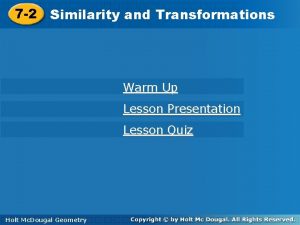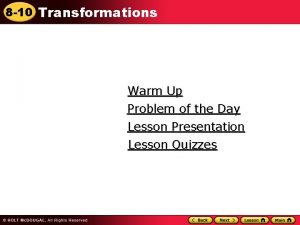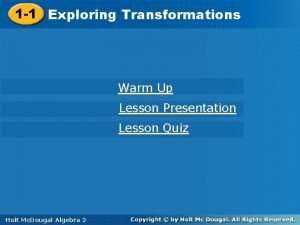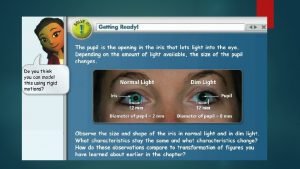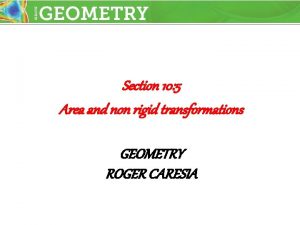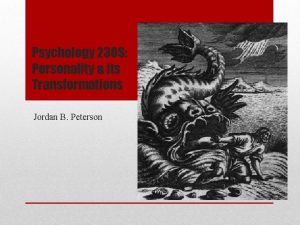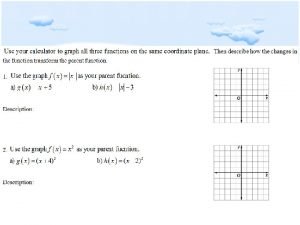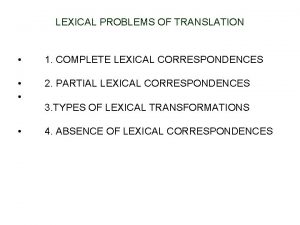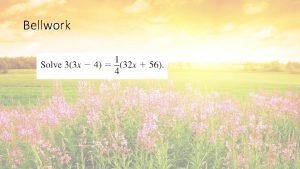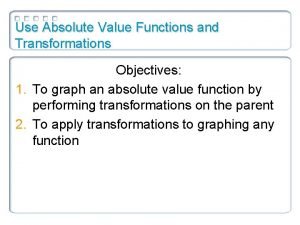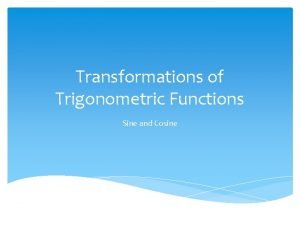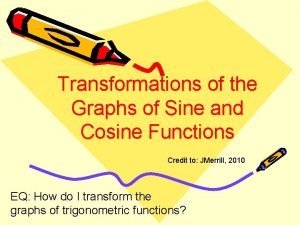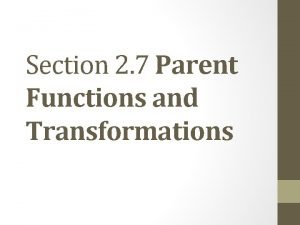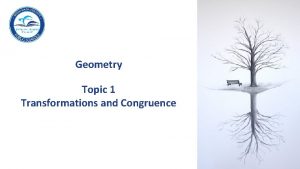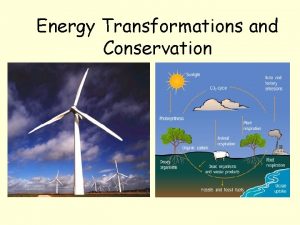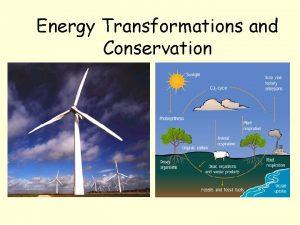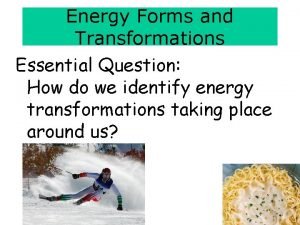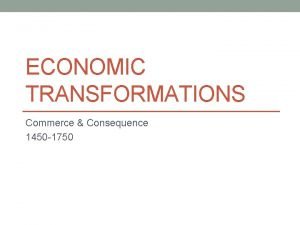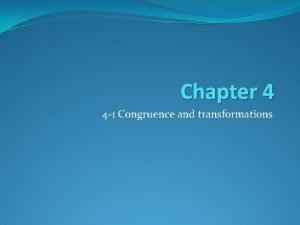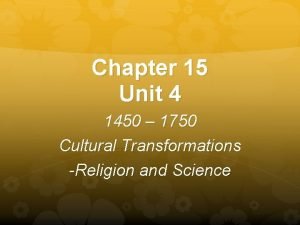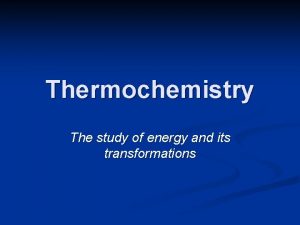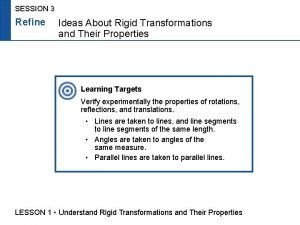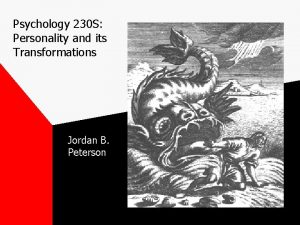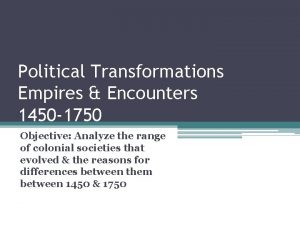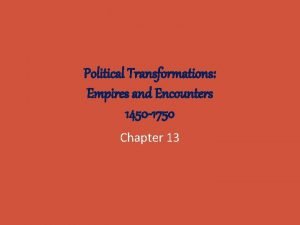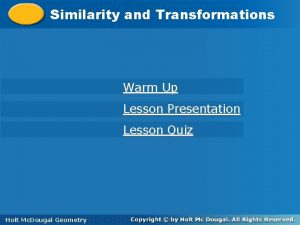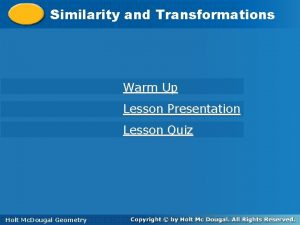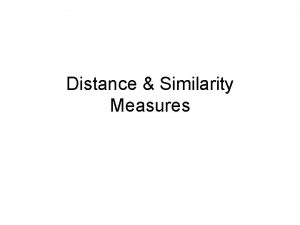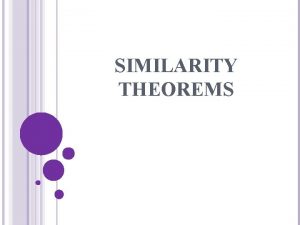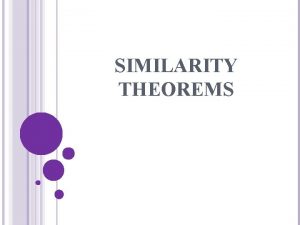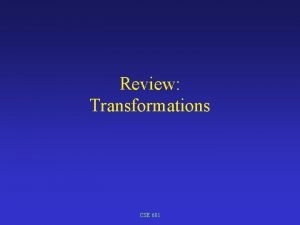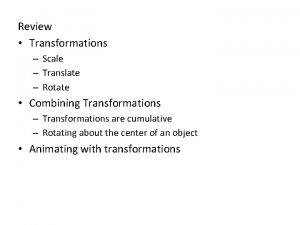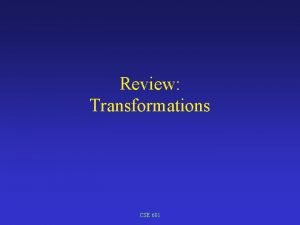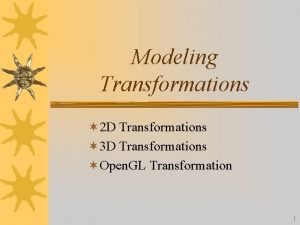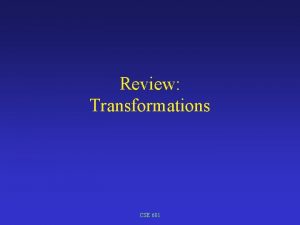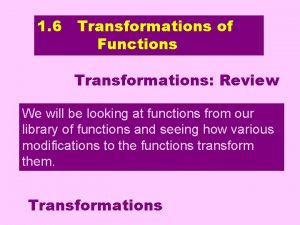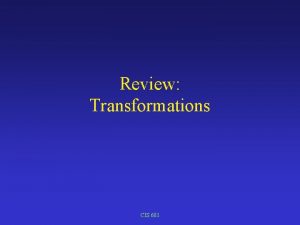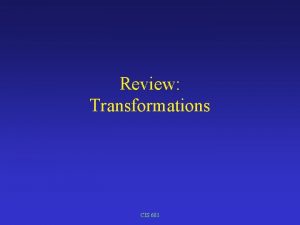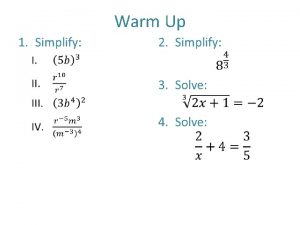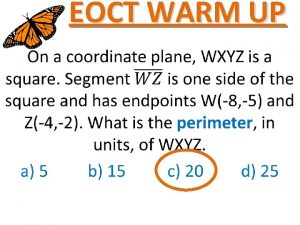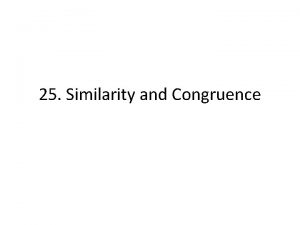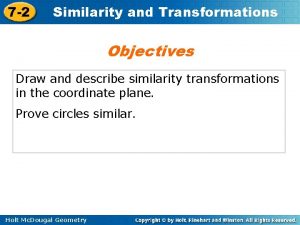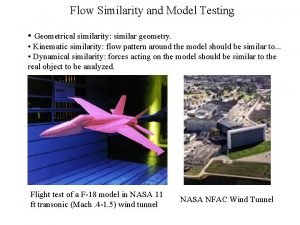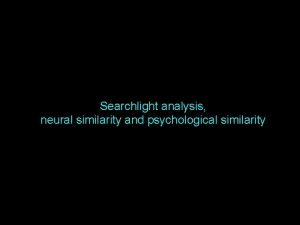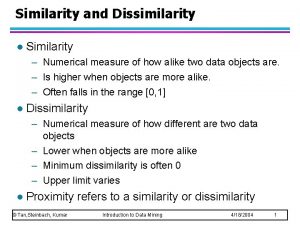Similarity and Transformations 7 2 Similarity Warm Up
























- Slides: 24

Similarity and Transformations 7 -2 Similarity Warm Up Lesson Presentation Lesson Quiz Holt. Geometry Mc. Dougal Geometry

7 -2 Similarity and Transformations Warm Up Find the image point when the indicated transformation is applied to the given pre-image point. 1. (x, y) → (x + 3, y – 1); (2, 4) (5, 3) 2. (x, y) → (x, –y); (– 2, 1) (-2, -1) 3. (x, y) → (3 x, 3 y); (– 5, 0) (-15, -0) 4. (x, y) → 1 x, 1 y ; (3, -6) 3 3 (1, -2) Holt Mc. Dougal Geometry

7 -2 Similarity and Transformations Objectives Draw and describe similarity transformations in the coordinate plane. Use properties of similarity transformations to determine whether polygons are similar and to prove circles similar. Holt Mc. Dougal Geometry

7 -2 Similarity and Transformations Vocabulary similarity transformation Holt Mc. Dougal Geometry

7 -2 Similarity and Transformations A transformation that produces similar figures is a similarity transformation. A similarity transformation is a dilation or a composite of one or more dilations and one or more congruence transformations. Two figures are similar if and only if there is a similarity transformation that maps one figure to the other figure. Holt Mc. Dougal Geometry

7 -2 Similarity and Transformations Remember! Translations, reflections, and rotations are congruence transformations. Holt Mc. Dougal Geometry

7 -2 Similarity and Transformations Example 1: Drawing and Describing Dilations A. Apply the dilation D to the polygon with the given vertices. Describe the dilation. D: (x, y) → (3 x, 3 y) A(1, 1), B(3, 1), C(3, 2) dilation with center (0, 0) and scale factor 3 Holt Mc. Dougal Geometry

7 -2 Similarity and Transformations Example 1: Continued B. Apply the dilation D to the polygon with the given vertices. Describe the dilation. D: (x, y) → 3 x, 3 y 4 4 P(– 8, 4), Q(– 4, 8), R(4, 4) 3 dilation with center (0, 0) and scale factor 4 Holt Mc. Dougal Geometry

7 -2 Similarity and Transformations Check It Out! Example 1 1 x, 1 y to the Apply the dilation D : (x, y)→ 4 4 polygon with vertices D(-8, 0), E(-8, -4), and F(4, -8). Name the coordinates of the image points. Describe the dilation. D'(-2, 0), E'(-2, -1), F'(-1, -2); dilation with center 1 (0, 0) and scale factor 4 Holt Mc. Dougal Geometry

7 -2 Similarity and Transformations Example 2 : Determining Whether Polygons are Similar Determine whether the polygons with the given vertices are similar. A. A(– 6, 3), B(-6, -6), C(3, 3), D(3, -6) and H(-2, -2), J(-2, 1), K(1, 1), L(1, -2) Yes; ABCD maps to HJKL by a dilation: 1 x, 1 y (x, y) → 3 3 Holt Mc. Dougal Geometry

7 -2 Similarity and Transformations Example 2: Continued B. P(2, 0), Q(2, 4), R(4, 4), S(4, 0) and W(5, 0), X(5, 10), Y(8, 10), Z(8, 0). No; (x, y) → (2. 5 x, 2. 5 y) maps P to W, but not S to Z. Holt Mc. Dougal Geometry

7 -2 Similarity and Transformations Example 2: Continued C. A(1, 2), B(2, 2), C(1, 4) and D(4, -6), E(6, -6), F(4, -2) Yes; ABC maps to A’B’C’ by a translation: (x, y) → (x + 1, y - 5). Then A’B’C’ maps to DEF by a dilation: (x, y) → (2 x, 2 y). Holt Mc. Dougal Geometry

7 -2 Similarity and Transformations Example 2: Continued D. F(3, 3), G(3, 6), H(9, 3), J(9, – 3) and S(– 1, 1), T(– 1, 2), U(– 3, 1), V(– 3, – 1). Yes; FGHJ maps to F’G’H’J’ by a reflection : (x, y) → (-x, y). Then F’G’H’J’ maps to STUV by a dilation: (x, y) 1 x , 1 y 3 3 Holt Mc. Dougal Geometry

7 -2 Similarity and Transformations Check It Out! Example 2 Determine whether the polygons with the given vertices are similar : A(2, -1), B(3, -1), C(3, -4) and P(3, 6), Q(3, 9), R(12, 9). The triangles are similar because ABC can be mapped to A'B'C' by a rotation: (x, y) → (-y, x), and then A'B'C' can be mapped to PQR by a dilation: (x, y) → (3 x, 3 y). Holt Mc. Dougal Geometry

7 -2 Similarity and Transformations Example 3: Proving Circles Similar A. Circle A with center (0, 0) and radius 1 is similar to circle B with center (0, 6) and radius 3. Holt Mc. Dougal Geometry

7 -2 Similarity and Transformations Example 3: Continued Circle A can be mapped to circle A’ by a translation: (x, y) → (x, y + 6). Circle A’ and circle B both have center (0, 6). Then circle A’ can be mapped to circle B by a dilation with center (0, 6) and scale factor 3. So circle A and circle B are similar. B. Circle C with center (0, – 3) and radius 2 is similar to circle D with center (5, 1) and radius 5. Holt Mc. Dougal Geometry

7 -2 Similarity and Transformations Example 3: Continued Circle C can be mapped to circle C’ by a translation: (x, y) → (x + 5, y + 4). Circle C’ and circle D both have center (5, 1). Then circle C’ can be mapped to circle D by a dilation with center (5, 1) and scale factor 2. 5. So circle C and circle D are similar. Holt Mc. Dougal Geometry

7 -2 Similarity and Transformations Check It Out! Example 3 Prove that circle A with center (2, 1) and radius 4 is similar to circle B with center (-1, -1) and radius 2. Circle A can be mapped to circle A' by a translation: (x, y) → (x - 3, y - 2). Then circle A' can be mapped to circle B by a dilation with center (-1, -1) and scale factor 1 So, circles A and B are 2 similar. Holt Mc. Dougal Geometry

7 -2 Similarity and Transformations Example 4: Application Eric wants to make a drawing to show he will arrange three rugs in his room. The large rug is twice the size of each small rug. Eric will first draw the small rug in the lower left corner and then the large rug in the middle. How can he draw those rugs? Holt Mc. Dougal Geometry

7 -2 Similarity and Transformations Example 4: Continue Place the lower left rug in the first quadrant of a coordinate plane in a convenient position. Apply the dilation with center (0, 0) and scale factor 2: (x, y) → (2 x, 2 y). Holt Mc. Dougal Geometry

7 -2 Similarity and Transformations Check It Out! Example 4 What if…? How could Tia draw the middle flag to make it 4 times the size of each of the other flags? Apply the dilation with center (0, 0) and scale factor 4: (x, y) → (4 x, 4 y). Holt Mc. Dougal Geometry

7 -2 Similarity and Transformations Lesson Quiz : Part-I 1. Apply the dilation D: (x, y) to the polygon with vertices A(2, 4), B(2, 6), and C(6, 4). Name the coordinates of the image points. Describe the dilation. A’(3, 6), B’(3, 9), C’(9, 6); dilation with center 3 (0, 0) and scale factor 2 Holt Mc. Dougal Geometry

7 -2 Similarity and Transformations Lesson Quiz : Part-II Determine whether the polygons with the given vertices are similar. 2. A(-4, 4), B(6, 4), C(6, -4), D(-4, -4) and P(-2, 2), Q(4, 2), R(4, -2), S(-2, -2) No; (x, y) → (0. 5 x, 0. 5 y) maps A to P, but not B to Q. 3. A(2, 2), B(2, 4), C(6, 4) and D(3, -3), E(3, -6), F(9, -6) Yes; △ ABC maps to △ A’B’C’ by a reflection: (x, y) → (x, -y). Then △ A’B’C’ maps to △DEF by a dilation: (x, y) → (1. 5 x, 1. 5 y). Holt Mc. Dougal Geometry

7 -2 Similarity and Transformations Lesson Quiz : Part-III 4. Prove that circle A with center (0, 4) and radius 4 is similar to circle B with center (-2, -7) and radius 6. Circle A can be mapped to circle A’ by a translation: (x, y) → (x - 2, y - 11). Circle A’ and circle B both have center (-2, -7). Then circle A’ can be mapped to circle B by a dilation with center (-2, -7) and scale factor 3 So circle A and circle B are similar. 2 Holt Mc. Dougal Geometry
 7-2 similarity and transformations
7-2 similarity and transformations Transformations warm up
Transformations warm up Transformations warm up
Transformations warm up A dilation is an enlargement if the scale factor
A dilation is an enlargement if the scale factor Rigid vs non rigid transformations
Rigid vs non rigid transformations Personality and its transformation
Personality and its transformation What is a parent function
What is a parent function Partial lexical correspondences
Partial lexical correspondences Parent functions and transformations
Parent functions and transformations Transformations of absolute value functions
Transformations of absolute value functions Trig function transformations
Trig function transformations Cosine wave
Cosine wave Lesson 2-7 parent functions and transformations
Lesson 2-7 parent functions and transformations Geometry topic 1 transformations and congruence
Geometry topic 1 transformations and congruence Running energy transformation
Running energy transformation Energy transformations and conservation
Energy transformations and conservation 100 examples of energy transformation
100 examples of energy transformation Economic transformations commerce and consequence
Economic transformations commerce and consequence 4-1 congruence
4-1 congruence Chapter 15 cultural transformations
Chapter 15 cultural transformations The study of energy and its transformations.
The study of energy and its transformations. Understanding rigid transformations and their properties
Understanding rigid transformations and their properties Precosmogonic
Precosmogonic Political transformations empires and encounters
Political transformations empires and encounters Chapter 5 political transformations empires and encounters
Chapter 5 political transformations empires and encounters
